Best known for making exceptional sparkling wines with extensive aging potential, Gramona is a winery that places the land and character of the fruit above all else. With 370 acres of vineyard, Gramona practices biodynamic winemaking to grow and vinify fruit reflective of their estate terroir. Likewise, the cellar is designed to maximize efficiency and conserve energy, and the wines are carefully made with minimal intervention. A winery that strives for complete harmony from vineyard to cellar, Gramona has earned a reputation for making some of the most sought-after sparkling wines in the world.



SINCE�2010
KEY�FACTS
CLIMATE: Mediterraneanclimatewithhot, drysummersandmoderatewinters;average annualtemperature59°F(15°F)
ELEVATION:�328-1,150feet (100-350m)
SOILS: Clayandcalcareousformationswith somealluvial,slatetowardMontserratMountain
CLASS: Corpinnat
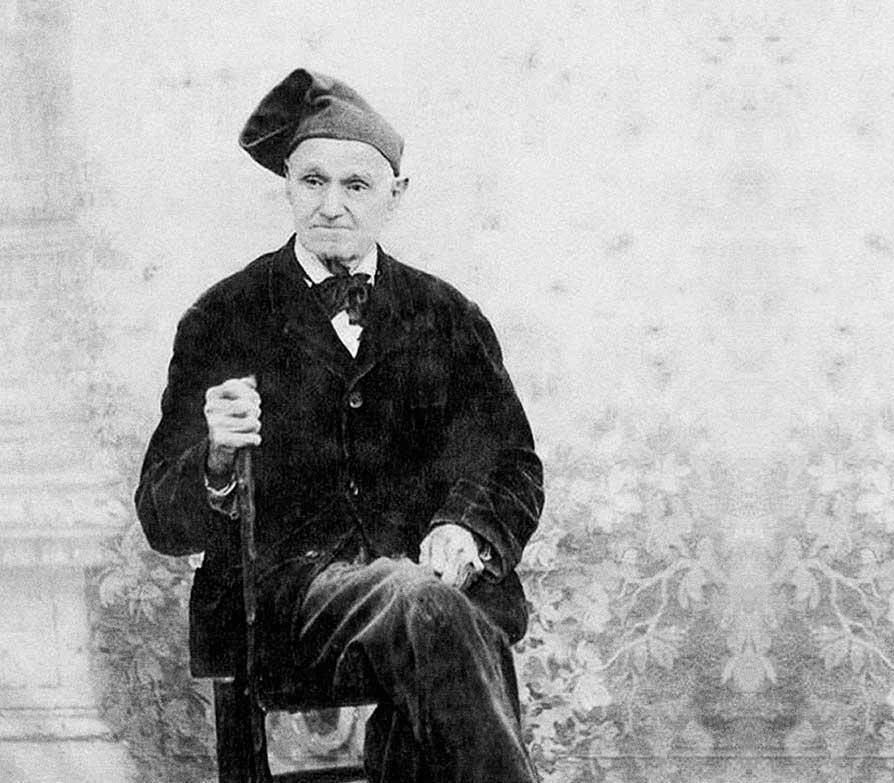
VINE: 370totalacres(150ha);308acres (125ha)GPE-approved
KEY�VARIETALS:�Xarello,Macabeo, Parellada





ECO: Demeter-certifiedbiodynamic producer; useofgeothermalandsolar energy,electricvehiclesandwater conservation



INNOVATE: Pursuingbiodynamic agriculture

HISTORY
The Gramona family has been working the land and making wine uninterrupted since the mid-19th century. It was at the start of the 20th century when two wine families – the Battles and the Gramonas – came together through marriage to launch the present winery. By 1945, with brothers Bartomeu and Josep at the helm, Gramona had emerged as a sparkling wine producer designed for long aging wines. The brothers led the winery until the end of the 20th century, before handing over operations to the next generation.

THE�FUTURE
The sixth generation of the Gramona family is taking on responsibilities alongside their parents so that the next handover is smooth and gradual. Roc and Leo specialise insustainableviticulture,winemakingandmanagement. Both share the energy of youth, love of new technologiesandrespectfortradition.

THE�FAMILY
Gramona is currently led by Jaume and XavierGramona,familymembersofdistinct but complementary dispositions. Jaume is known for his determination and exacting standards, while Xavier is a thoughtful analyst, thinker and dreamer. Both share a commitment to making exceptional Catalansparklingwine.

Winemakers: Leo Gramona and his father Xavier, and JaumeGramonaandhissonRoc

TERROIR

The vineyards of Gramona are primarily located in the subzones of Costers de Lavernó with additional holdings in the Vall de Bitlles of Central Penedès. The vineyards are protected to the north by the Montserrat mountains, which provide shelter from harsh winters. Several rivers flow through the property, including the Penedès, the Bitlles and the Foix. The average elevation is 820 feet(250m).



Among the vineyards are woods where the estate’scows,sheepandhorsesgrazefreely.

To increase biodiversity, the biodynamic farm is also home to geese, chickens, dogs, peacocks, donkeys and even falcons in summer, justbeforeharvesting.


VITICULTURE�&�WINEMAKING
BIODYNAMIC VITICULTURE


Everything on the Gramona estate is guided by a biodynamic philosophy. Natural grass cover is maintained to obtain spongysoils;plantinfusionsareappliedtowardoffpests;andanimalandvegetalcompostisproducedtonurturetheearth andvines.

BIOCLIMATIC ARCHITECTURE
Located at the center of the property, Celler Batlle reaffirms Gramona’s commitment to sustainability and biodynamics. Two-thirds of the cellar is built underground, reducing environmental impact and energy consumption. It is a château concept,groupingplotsofmorethanonegrapevarietyaroundthewineryattheheartoftheestate.
LONG-AGED SPARKLING WINE
Gramona’s signature style is sparkling wine capable of long aging. In 1951, Bartomeu and Josep Lluis Gramona first observed the considerable potential for maturation of the Xarello grape and decided to produce a revolutionary single-varietalsparklingwine,madeforaging.TheIIILustroscuvéewasbornfromextraordinaryfruitgrownintheLaPlana and Paraje Font de Jui vineyards, and aged a full 10 years. Ill Lustros was followed by the Celler Batlle, another 10-year old release,cementingGramona’sreputationasa leadingproducerofSpanishsparklingwine.
Gramona hired Lydia and Claude Bourguignon, consultants who specialize in soil microbiology, to carry out anin-depth study of the soils, with the objective of maximizing soilhealth.
How�is�the�terroir�reflected�in�the� wines�of�Gramona?
Gramona’s soils are clay and calcareous-loam with alluvial soil near the Anoia River and slate closer to Montserrat.Thesesoilsarealsocharacterisedbythe presence of têtes de poupées, calcareous formations of bacterial origin, which lend a refreshing minerality to the wines while enriching thesubsoil.
These characteristics allow the production of highacidity base wines from neutral pH soils. After the long periods of bottle aging, the wines maintain a vibrant,livelycharacterofasavorymineralsensation on the palate, which blends with the notes of maturityandcomplexity.
Singularities�of�the�Winery
The family has been cultivating their estate since 1850, which gives them an intimate knowledge of their lands and varieties, and generations of experience creating long-aged sparkling wines. Their dedication to quality led them to form the collective Corpinnat to defend quality sparkling wines produced from organic grapes in the heart of Penedès.

Why�is�Gramona�a�Grandes�Pagos�de� España�winery?
Gramona’s ambition to highlight its unique personality by focusing on long-aging method sparkling wine from the best vineyards is well-supportedbyGrandesPagosdeEspaña.



GRAMONA�PORTFOLIO:

Imperial, Innoble, Argent, Argent Rose, III Lustros, Celler Batlle, Enoteca
Gramona�Imperial Corpinnat


Varieties
Xarello (50%), Macabeo (30%), Parellada (15%), Chardonnay (5%)
Vinification
Brut aged over 50 months before disgorgement
Good�to�Know
The expedition liqueur is from their solera, well over a century old
Gramona�III�Lustros Corpinnat
Varieties
70% Xarello, 30% Macabeo
Vinification�

Brut Nature aged 80 months under cork stopper
Good�to�Know
Grapes from the Font de Jui pago
GRAMONA
Industria 36 08770 Sant Sadurni d’Anoia Barcelona
GRAMONA.COM @GRAMONA1881 Contact:�Ana�Lopez
LEARN�MORE
analopez@gramona.com
An historic Rías Baixas winery, Fillaboa is one of the largest and most beautiful estates in Galicia. Located near the Portuguese border in Salvaterra Do Miño (Pontevedra), between the Tea and Miño rivers, the 17th century estate sits on an 182-acre property framed by an old world stone wall and a stunning 15th century Romanesque bridge. The property encompasses a traditional manor house and an abundance of natural plantings, from magnolias to cork trees, and, of course, vineyards dedicated to 100% Albariño wines. Fillaboa is known for terroir-driven wines that reflect the legacy of their singular estate.



SINCE�2004
KEY�FACTS
CLIMATE: Atlantic:mildtemperatures,and abundantrainfallintheautumnandwinter months
ELEVATION:�Upto492feet(150m)





SOILS: Graniteandalluvialwithriverstones; sandyloamtexture
VINE:� 124acres(50ha),dividedinto12 south-facingparcels;112acres(45ha)are GPE-approved


KEY�VARIETAL:�100%Albariño
ECO: Committedto biodiversity, vineyardsareinterspersedwitholivetrees andgardens

INNOVATION: Pushingthelimitsof aginginAlbariño,encompassingunoaked winethatshowcaseanagedstyle
HISTORY
According to winery lore, when the Romans first passed through the Fillaboa property 2,000 years ago, they immediately knew the vines were special. Grapes have been cultivated here for generations, including for wines sent to the Pope. In the years that followed, illustrious tenants cared for the land, committed to preserving its magic. In 2001, the Masaveu family purchased Fillaboa and expanded the estate and its production.
SUSTAINABLE�VALUES
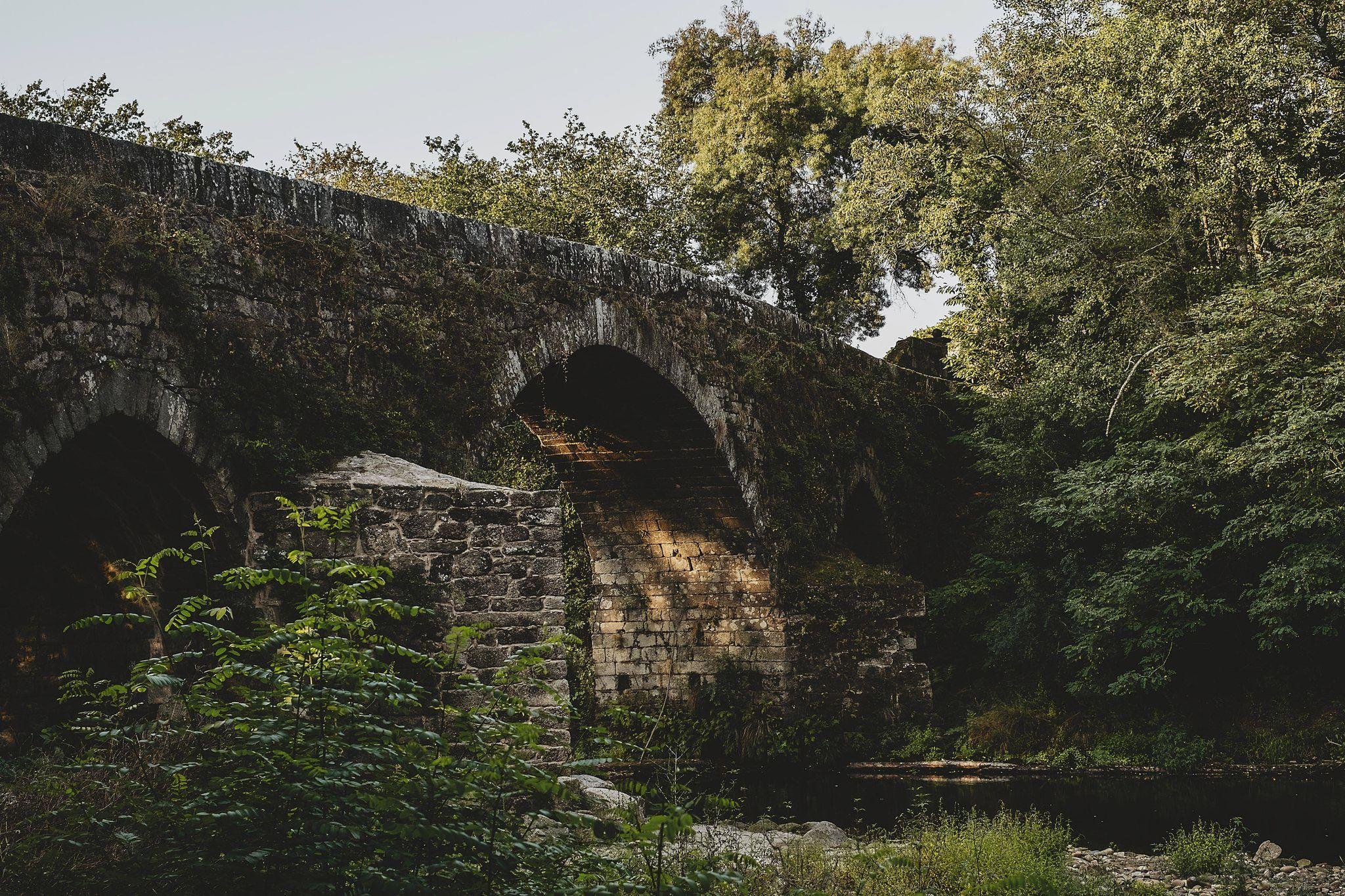
AtFillaboa,thenaturalworldsurroundsyou. In an effort to protect the groundwater and nearby rivers, Fillaboa developed a wastewater treatment plant that cleans and processes all water in the winemaking process. The winery uses ultraviolet light to eliminate possible microorganisms present in the water and a phytobacteria system to decompose viticultural treatment products through natural microbiological action Theytreatthewaterfortheirownusewithin the winery, but also to make sure any water that goes back into the ground is free from pollutants.
THE�TEAM
Fillaboa is owned and operated by the Masaveu family, whotracetheirwinemakinghistorybacktotheirancestor DonFedericoMasaveuRivel,whofirstownedvineyardsin the mid-19th century in Catalunya. José Masaveu Herrero is the CEO of Masaveu Bodegas and has worked in the winesectorforover20years.
Isabel Salgado has been Fillaboa’s winemaker for 24 years and has been making Albariño wines for 28 years. With Albariño in her veins, she is driven by the the uniquely diverse terroir of Fillaboa and the magic of Galicia.
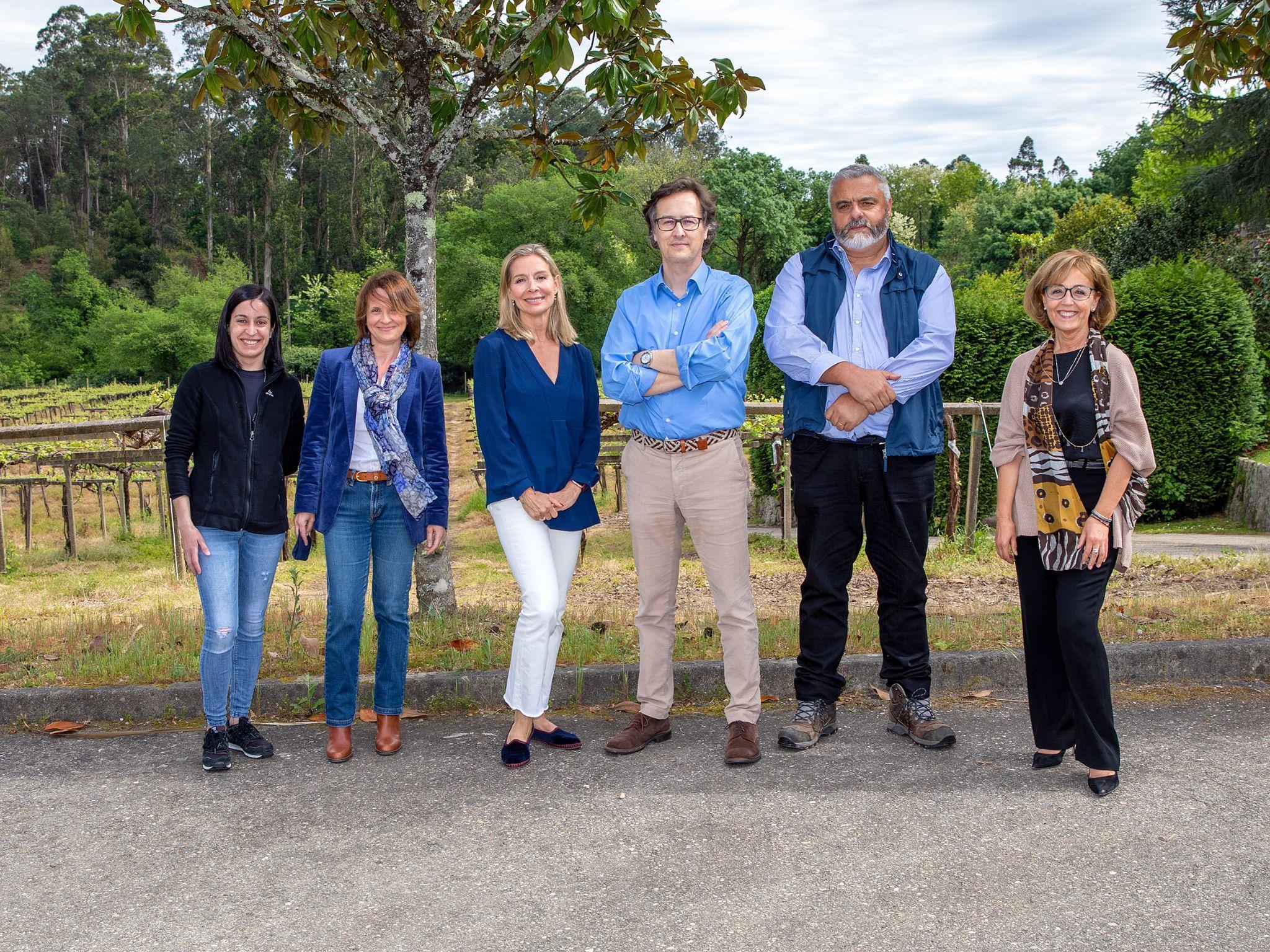

TERROIR




Fillaboa’s terroir is defined foremost by its rolling hills near the Miño and Tea rivers, home to a range of animal life and vegetation including alluvial forests and Atlantic wet argan. Decomposed granite called xabre in Galicia predominates with sandy loam texture and river stones throughout, producing exceptionally clean, aromatic wines. The acidic soils reinforce Albariño’s refreshingacidityandthesandycompositionfacilitatesdrainage.
An exhaustive soil study conducted in 2017 has enabled Fillaboa to identify and cultivate 12 distinct parcelstorealizetheirfullpotential.
Located in the Condado do Tea subzone of Rías Baixas, Fillaboa benefits from an Atlantic influence with abundant precipitation in autumn, winter and spring. While the fall and spring are temperate, summer temperatures can reach as high as 104°F (40°C) with ample diurnal temperature shifts. Due to the relatively higher temperatures of this subzone, Albariño has a distinct aromatic profile with pronouncednotesofstoneandtropicalfruits.

FACT
VITICULTURE�&�WINEMAKING


ALBARIÑO Bodega Fillaboa produces wine that expresses the subtlety and depth of their terroir. Albariño, the renowned native grape of Rías Baixas, shows complex aromatics and beautifully structured acidity that make memorable, elegant wines. Fillaboa is fermented in stainless steel tanks and ages on fine lees for six months, lending texture and complexity. Due to the strong backbone of alcohol and acidity, Albariño ages exceptionally well, gaining depth and complexity over time.
ARTISANRY All wines are produced in small volumes from unique parcels and vinified separately, ensuring care and attention is maintained at every step. Operating with a philosophy of minimum intervention, Fillaboa use only native yeasts in fermentation. The wines are not clarified and minimal doses of ascorbic acid and sulphur are the only products added. Duetotheripenessofthegrapes,thewinesusuallydonotgothroughmalolacticfermentation.
FINCA MONTE ALTO TheprizedMonteAltopago,whichfeatures17acres(7ha)ofvineyardthatsitatthehighestpointof theestate,isespeciallynoteworthy.BenefittingfromastrongAtlanticcharacter,thisemblematicplotlies492feet(150m) abovesealevel.ProximitytotheMiñorivergivesthesoilasandy-loamtexturewithlotsofpebbles,idealforcultivation. The winesmadefromthisparcelareextremelylimited–Fillaboaproducedunder1,000caseslastyear.
Fillaboa trellises many of the vines with the traditional parra system, which elevates widely spaced vines up to seven feet (two m) off the ground on traditional granite pillars, allowing air to circulate and preventing mold and rot from developing in the humid conditions.
Due to the unique combination of its mild Atlantic climate and well-drained soil, Fillaboa is an ideal site for the native Albariño to thrive.
How�is�the�terroir�reflected�in�the�wines� of�Fillaboa?
The Albariño cultivated in Fillaboa vineyards shows ripe fruit like pineapple and citrus, and balanced acidity when young. The Atlantic influence, southern hillside exposures, granitic and alluvial soils and lees-aging produce wines rich in substance that evolve and age without the intervention of oak. The acidity will continue to support the palate and the aromaticsforyearstocome.
Fillaboa prides itself on balanced wine. Foregoing any malolactic fermentation, the acidity instead balances the alcohol, producing exceptionally drinkable wines thatmaintaintheircomplexitywithage.



BODEGA�FILLABOA� PORTFOLIO:
Fillaboa Selección Finca Monte Alto, Fillaboa, Fillaboa 1898
Singularities�of�the�winery


Fillaboa is the largest estate in Pontevedra province, and contains one of the largest single extensions of vineyard in all of DO Rías Baixas. It is a rare example ofachâteau-stylewineryintheregion.



Contact:�
Teresa�Muñoz tmunozv@bodegas.masaveu.com
Blend of eight parcels with vines from 18-31 years. Aging potential up to three years
Vinification
12 months on the lees in stainless steel tanks Good�to�Know Limited production, aging potential of five-eight years
Didier Belondrade wanted to create a French-style “vin de château” where the wines would authentically express thier terroir of origen. His discovery of the untapped aging potential of Verdejo led him to Rueda. In 1994, Belondrade’s dream came true when his winery launched in Nava Del Rey. Two years later, the first vintage of Belondrade y Lurton was released and its success echoed around the globe as the winery debuted in the Japanese and American markets. Today, Belondrade has expanded its selection of wines while maintaining its commitment to the Castilian Meseta and its terroir.



SINCE�2015
KEY�FACTS
CLIMATE: Continental:coldwintersand short,warmsummers;highdiurnaltemperature shifts.HighwindsfromApriltoJuly
ELEVATION:�2,460feet(750m)
SOILS: Mixofsand,clayandpebbles alongsidelimestoneveins





VINE: 98acres(40ha)ofvineyards,divided into23plotsofvaryingsizesandages
KEY�VARIETALS:�Verdejo,Tempranillo, Syrah,smallamountofwhiteRhonevarieties

ECO: Certifiedorganic;installationofsolar panelstosupportrenewableenergyuse

INNOVATE: Experimentswithcovercrops
CLASS: DORueda,VdTCastillayLeón
HISTORY
The production of Belondrade wines began in a rented facility in Nava del Rey in 1994. Now, they are produced in the winery’s own facility located in the town of La Seca, on top of the Castilian plateau and just a few kilometers from the Duero River in Tordesillas. The winery was designed by Vincent Defos du Rau and is reminiscent of the Castilian Meseta, which seamlessly blends into its surrounding environment. In 2012, 12 years after the opening of the winery in La Seca, Belondrade inaugurated the barrel cellar. They will debut a new building in 2023 inspired by Mies van der Rohe’s Farnsworth House (Illinois, USA) which will house the offices and the reception center.



THE�FAMILY
Belondrade is a family winery with 14 team members. Though founder Didier Belondrade is active in leadership, son Jean oversees daily operations. Jean has been around the winery since he was a child, and wanted to continue in the family business. He studied the famous DUAD in Bordeaux and holds an MBA. Experiences in France, Chile and Germany added depth to his understandingofterroirandpassionforthewineworld.
Early on, Didier chose Winemaker Marta Baquerizo to be an accomplice in realizing his unorthodox vision of Verdejo. She studied enology in Bordeaux and interned at Pétrus. Marta was one of only three women winemakers in Rueda at the time, and since has mentored many young winemakers in her more than 20yearsatBelondrade.
In 2015, the Belondrade Arte y Vino Foundation was created as a way to highlight and promote all forms of artistic interpretation and make them accessible to society. Didier Belondrade believes that a discussion of interpretation is the bridge between the worlds of art and wine.

SUSTAINABLE�VALUES
As a fierce advocate of sustainable practices from the start, Belondrade has maintained a commitment to the Castilian Meseta and local biodiversity. In 2007, the estate produced its first wine using indigenous yeasts and 100% spontaneous fermentation, and obtained organic certification in 2010. In 2016, Belondrade’s obsession with diversity and character led to the acquisition of two more plots of old vines–LaAlamedaandLaCruz.Theirlatest projects include experimenting with different cover crops to encourage soil regeneration.


TERROIR



The soils on the plateau date from the Cenozoic (or Tertiary) Era, forming around 60 million years ago and are characterized by their low content of organicmatter.Theyareprimarilymadeofalayerofpebblesaround10to 60 centimeters (4 to 24 inches) thick, a layer of clay subsoil and a deep layer of limestone. In each of the 23 plots, there is a mix of pebbles, sand, clay and limestone, which in varying percentages lends each wine unique styleandpersonality.Plotsarealsodifferentiatedbytherelativeageofthe vines,theorientation,plantingdensityanddistinctpruning.
The climate is continental with little rainfall, characterized by long, cold winters and short, hot summers. Great thermal amplitude between day and night allows for phenolic maturity and high acidity, lending complexitytothefruit.


 La�Seca
La�Seca
VITICULTURE�&�WINEMAKING



VITICULTURE Plowing encourages soil aeration (oxygen supply to support proper development of microorganisms and the root system) and eliminates weeds, limiting the damage from spring frosts and improving the capture and use of rainfall.Experiments with different cover crops are used to study their impact on soil regeneration. A relatively long, late pruning inhibits the growth of the buds and prevents possible damage from late frost and hail. Summer pruning is usually done to choose the formation of future bunches and foster aeration. Green harvesting ensures even ripening and closer yield management.
VINIFICATION All 23 parcels are vinified separately using spontaneous fermentation with native yeasts. Wines are aged on lees in tanks or barrels of different characteristics and volumes, including trials with concrete. Lees aging adds volume on the palate, and the slow micro oxygenation from aging with lees in barrels leads to pastry and brioche notes on the nose.
THE ART OF ASSEMBLAGE Belondrade’s philosophy is that the best expression of terroir is achieved by blending. Each parcel helps produce finesse, structure, length and elegance, and Belondrade uses this range to produce their own singular cuvées. The tasting process begins in February which defines each new vintage of Quinta Apolonia. Didier and Jean Belondrade, together with Marta Baquerizo, then choose the final assemblage of Belondrade y Lurton in June to represent the diversity of terroir and the conditions of each vintage. Quinta Apolonia is blended as an interpretation of the Verdejo variety, using both stainless steel and barrel-fermented wines.
Two of Belondrade’s annual releases – Quinta Apolonia and Quinta Clarisa– are named after Didier Belondrade’s daughters.

How�is�the�terroir�reflected�in�the� wines�of�Belondrade?
Belondrade’s wines explore the elegance and aging potentialofVerdejo.Plotswithahigherproportionof clay (such as La Bodega and Cantarranas) provide morestructure,whilethosewithsandiersoil(suchas Camino Ventosa) offer finesse and freshness. A pronounced salinity is attributed to the limestone veins that cross some plots such as Cañada and Tomillar Grande. The presence of river stones contribute to the development of phenolic maturity whilepreservinghighacidities.


The wines show notes of fennel, hay, honeysuckle and citrus fruits on the nose, as well as structure, acidityandbitternessonthepalate.
Singularities�of�the�winery
Belondrade was a pioneer in exploring the aging potential of Verdejo. The wines helped shape the world’sunderstandingofthevarietyanditspotential toexpresstheterroirofLaSecainRueda.

Why�is�Belondrade�a�Grandes�Pagos� de�España�winery?
Belondrade joined GPE in 2012 to defend and promote a concept which has always been a part of the estate’s identity: terroir. The association is a platform to gather the voices of some of Spain’s most recognized and respected producers in order to promote Spanish wines’ uniqueness and identity aroundtheworld.

BELONDRADE�PORTFOLIO:

Belondrade y Lurton, Belondrade Quinta Apolonia
BELONDRADE�Y�LURTON DO Rueda
Varieties
Varies by vintage: 95% Verdejo, 5% other varieties
Vinification
9 months French oak on lees, 5+ months bottle aging
Good�to�Know
Grapes are sorted up to three times (hand harvested, sorting machine and sorting table) ensuring that the best will be used
BELONDRADE QUINTA�APOLONIA
VdT Castilla y León
Varieties
Varies by vintage: 95% Verdejo, 5% other varieties
Vinification�


⅓ barrel-fermented, ⅔ fermented in stainless steel and concrete tanks

Good�to�Know
Grapes from same vineyards as Belondrade y Lurton
LEARN�MORE
BELONDRADE.COM� @BELONDRADE.VINOS Contact:�Jean�Belondrade� info@belondrade.com BELONDRADE Paraje de los Levantes Quinta San Diego 47491 La Seca Valladolid
Framed by the medieval castle of Alarcón to the west and the Hoces del Cabriel nature preserve to the east, Finca Sandoval is located in Ledaña, between the Júcar and Cabriel rivers in the DO Manchuela. With 62 acres (25 ha) of organically farmed vineyards, Finca Sandoval is preserving parcels of old traditional varietals and reviving the viticultural tradition in this little-known area of Spain .



SINCE�2000
KEY�FACTS
CLIMATE: Mediterraneanwithaverage temperatureof56°F(14°C)





ELEVATION:�969-3,281feet (296-1,001meters)
SOILS: Clay,sand,gravel,calcareous
CLASS: DOManchuela
HISTORY
Finca Sandoval began in 1998 when journalist and food critic Víctor de la Serna decided to plant a vineyard of Syrah and an experimental plot of the Portuguese variety Touriga Nacional. In 2019, Anta Winteries acquired the estate. Anta’s wine-loving entrepreneurs, led by Ángel and Germán García-Cordero and the former director of Freixenet, Diego Jiménez, recognized the potential to produce high-quality wines from the many 50-year-old vineyard plots that make this region unique in Spain

From the left: Co-CEO Germán García-Cordero, President Ángel García-Cordero, Co-CEO Diego Jiménez

VINE: 61acres(25ha)across10parcels
KEY�VARIETALS:�Syrah,Bobal, MoraviaAgria,Monastrell,GarnachaTinta


ECO: Certifiedorganic

In 2019, Anta Wineries added winemaking and viticulture advisor Javi Revert to the team. He brings a more contemporary style to the wines, and has worked to recover old plots of the area, especially the Bobal variety. This work is reflected in the scores and commentsofwinecritics.
SUSTAINABLE�VALUES
All plots at Finca Sandoval, whether owned or leased, are certified organic and cultivated without phytosanitary additives. Committed to sustainable ecological practices, Finca Sandoval has incorporated biodynamic methods, such as bottling wines in accordance with the biodynamic calendar.

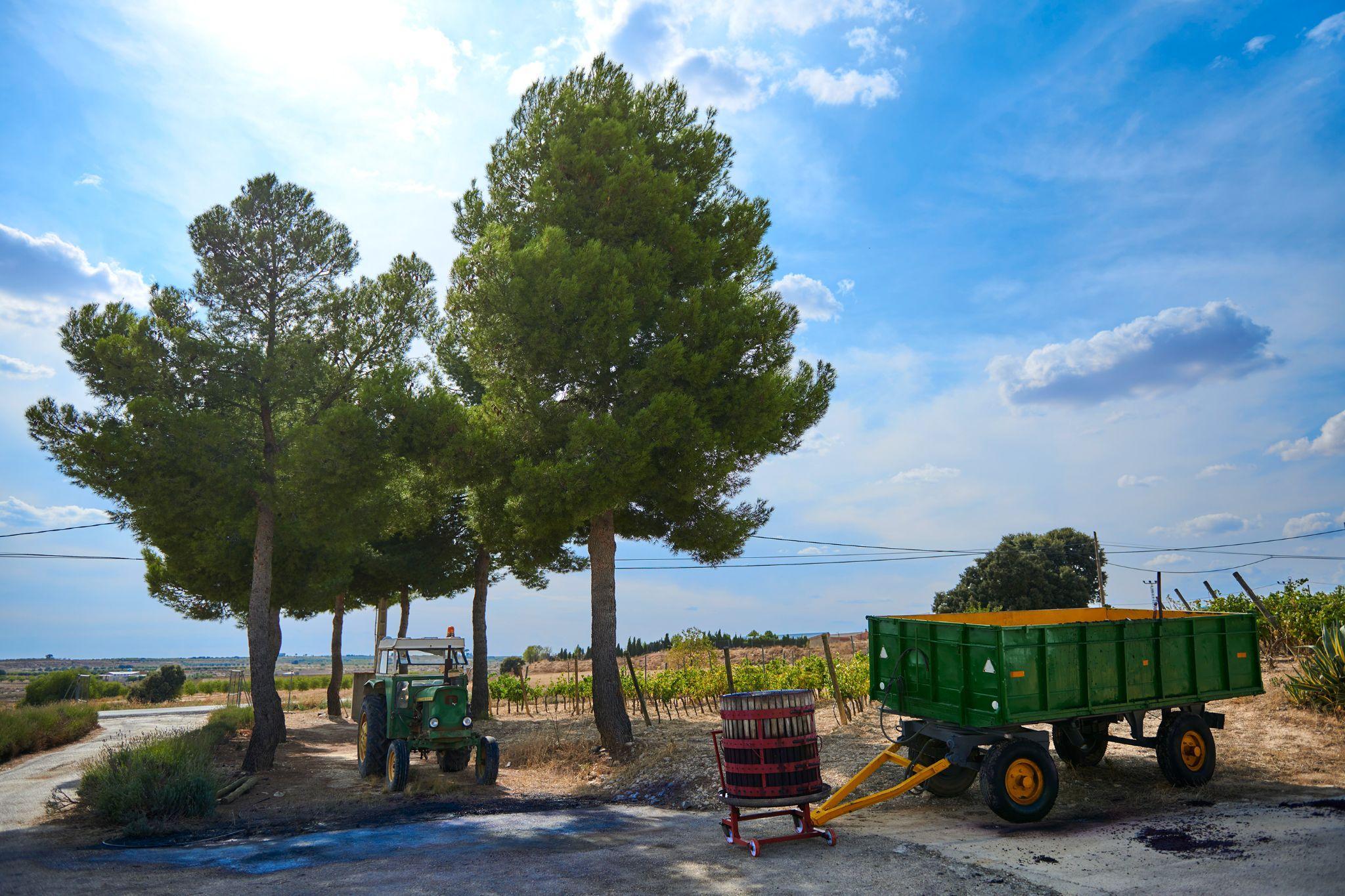
 Winemaker: Javier Revert and Winery Partner Germán GarcíaCordero
Winemaker: Javier Revert and Winery Partner Germán GarcíaCordero
TERROIR


Finca Sandoval is primarily defined by its altitude, which reaches upwards of 3,000 feet (915 meters). This altitude gives the wines a notable freshness without sacrificing their Mediterranean character.
The Mediterranean climate has long, very dry, hot summers. When combined with the altitude, these conditions yield great thermal amplitude, lengthening the growth cycle and producing more balanced ripening of the grapes.


The clay soils have an important limestone component. The vines rest on a limestone rock-base called tuesca in Manchuela, with depths ranging from 16 to 40 inches (41 to 102 cm). Soil composition is primarily sandstones and conglomerates, with layers of yellowish sandy loams and limestones.

Paraje Casablanca, Finca Sandoval’s largest parcel with 62 acres (25 ha) and four grape varieties, contains five distinct soil types. They show differences in levels of key components like organic material, calcium carbonate or iron. The winery vinifies each variety and soil type separately to maintain the character of each.

GOOD�TO�KNOW
Sandoval champions the Bobal variety. While the grape is widely planted, it doesn’t enjoy the reputation of more commonly understood European varieties. The medium-bodied red grape makes wines with crisp, structured acidity.

VITICULTURE�&�WINEMAKING

CAREFUL VITICULTURE
In2020,FincaSandovalchangedthetrainingandpruningsystemstoencouragegreaterdevelopmentofthecanopy.This promoted shading of the bunches, which yields larger, more concentrated fruit and wines of more fluidity, freshness and elegance.
AGING IN CLAY
Recovering local winemaking practices for their Fundamentalista bottling, Finca Sandoval is experimenting with clay amphora known as lastinajas– the traditional aging vessels of Manchuela. The team feels wine aged in the amphora best expresses the estate’s terroir and their work in the vineyard. The clay’s porosity allows the winemakers to perform controlledmicro-oxygenationwhilepreservingintensityoffruitandthefreshnessofthewine.
ART OF BLENDING
Finca Sandoval maintains the European tradition of blended wines, even when one variety dominates. For instance, their Finca Sandoval bottling is primarily from low-yield, old-vine Syrah, but it is blended with native grape varieties like Monastrell,GarnachaandBobaltoaddcomplexityandlocalcharacter.
Moravia Agria is an heirloom grape native to Manchuela, the only DO that permits its use in wine. It is a sensitive variety with very thin skin that produces relatively low alcohol content (approx. 12.5%) and notable acidity. Finca Sandoval uses Moravia Agria in blends to add freshness and acidity.

How�is�the�terroir�reflected�in�the� wines�of�Finca�Sandoval?
Finca Sandoval is driven by the desire to make wine that reflects the specific terroir of their various plots. For example, La Fundamentalista is a field blend sourced from a high elevation plot where old-vine Bobal is coplanted with Moravia, Marisancho and Tortosina. The fruit is co-fermented, allowing the vineyard character to shape the wine. The resulting winesshowgreatverticality,acidityandfreshness.

Salia, on the other hand, is composed of Syrah, Bobal and Touriga Nacional from separate plots. They are vinified separately to preserve the identity of their growing site. The predominantly clay soils yield wines that are round on the palate with more volumeandintensefruit.


FINCA�SANDOVAL� PORTFOLIO:

Fundamentalista, Salia, Finca Sandoval, Signo Bobal, La Rosa, Aurora
Singularities�of�the�Winery
FincaSandovalhasworkedtoputManchuelabackon the viticultural map, recovering the best of the area’s vines and winemaking traditions. Their combination of new and old technology is uncovering layers of expressionoftheirfruitandterroir.
Why�is�Finca�Sandoval�a�Grandes� Pagos�de�España�winery?
Finca Sandoval is a founding member of GPE. Victor de la Serna has long been a champion of single-estate wines that display characteristics of a particular soil type, orientation, microclimate or cultivar – the definition of pago wines. Like fellow members, they produce wines in harmony with the soil,climateandnatureofeachpago.
Finca�Sandoval�
Varieties
80% Syrah, 15% Bobal, 5% Moravia Agria
Vinification
Vinified with 40% whole cluster fruit, spontaneous fermentation with natived yeast; aged 18 months in large foudres
Good�to�Know
Blend from the best parcels of the Casablanca vineyard

Varieties
60% Syrah, 25% Bobal, 20% Touriga Nacional, 5% Garnacha
Vinification�



Vinified with 40% whole cluster fruit, spontaneous fermentation with native yeast; aged 10 months in 300 L French oak barrels
Good�to�Know
All fruit comes from the same municipality
FINCASANDOVAL.COM �����@FINCASANDOVAL Contact:�Marcos�Mendez marcos@fincasandoval.com LEARN�MORE
Salia� DO Manchuela
DO Manchuela
Located in the Montes de Toledo region, in the area of influence of Cabañeros Natural Park, Pago de Vallegarcía is known for a pioneering spirit that brought the great traditions of French viticulture to Spain. The wines seek to give expression to singular terroir formed in the valleys of the Montes de Toledo. The results have been stunning, such that renowned French winemaker Eric Boissenot – the man behind many of the world’s most famous Bordeaux –now lists Vallegarcía as his only Spanish project. With a restless spirit and commitment to innovation, Vallegarcía stands poised to continue its work in making unique, terroir-driven Spanish wine.



SINCE�2000
KEY�FACTS
HISTORY

Pago de Vallegarcía began in 1997, when Alfonso Cortina de Alcocer commissioned Dr. Richard Smart, renowned professor of Australian viticulture, to design a vineyard on the Vallegarcía estate. Motivated by his love of the great wines of Burgundy and Bordeaux, Cortina began with 59 acres (24 ha) of primarily French varietals. The reception of the first wines from the estate encouraged Cortina to build his own winery, and on September 14, 2006, King Juan Carlos I inaugurated the new facilities.
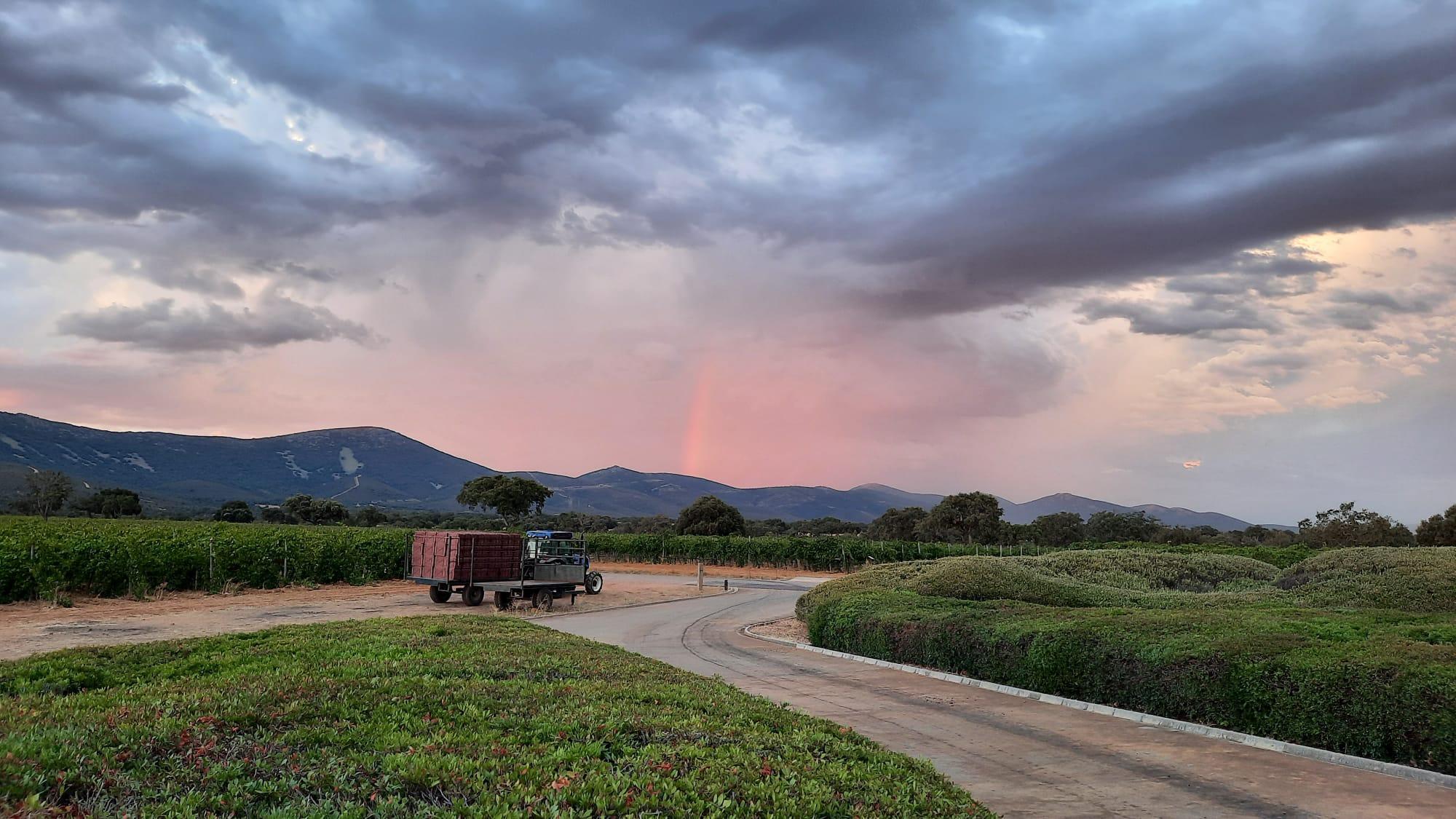
Vinification occurs in a minimalist building on the property designed by Martinez Pita. The winery was designed to reflect a respect for the surrounding environment: discreet form, natural materials, and a color palette borrowed from the vineyards allwork together to minimize the visual impact on the landscape.
THE�TEAM
Adolfo Hornos has been with Vallegarcía since its inception. He started in 1997 as vineyard manager and helped in the design and construction of the winery; today he serves as general director, technical director andwinemakerofVallegarcía.
Adolfo has a master’s degree in viticulture and enology, andinagri-foodindustrymanagement.


Winemaker: AdolfoHornos
Montes de Toledo, and home to refuge of large raptors, black storks, eagles and vultures. It is also the habitat of medium-sized carnivores such as the wildcat, the gineta, the garduña, the meloncillo and the badger that compete with the Iberian lynx for its main prey, the rabbit.
Solar panels have recently been installed asasourceofrenewableenergy.

TERROIR

Surrounded by valleys and mountains, the Vallegarcía vineyard is situated on raña, which are slopes and plains at the bottom of a mountain that have been eroded by water and rainfall. They are composed of alluvial deposits from the mountainsides, and by very weathered slates and quartzite blocks on a sandy matrix.


The estate receives more rainfall during the year than other areas of the province, though summer brings an absence of precipitation. This, coupled with the relative altitude, brings a natural freshness to the wines even with highalcoholandmoderateacidity.



One of the more distinguishing traits of the soil is its quartzite origin with no presence of limestone, which offers a nuanced sense of minerality. There are alsohighlevelsofclay,whichretainswaterwhilemakingitdifficultforthevine tomakeuseofit.ThelowsoilpHisanotherfactor,facilitatingalowerpHinthe mustsandwines.

Vallegarcía uses various canopy training systems according to the variety: Smart Dyson, cordon royat, vertical axis and California T trellis.

VITICULTURE�&�WINEMAKING


CREATING TRADITION
WhenVallegarcíaFounderAlfonsoCortinacametotheregion,therewasnowinemakingtraditiontospeakof,sohemade hisown.“IchoseFrenchgrapesbecausetheyaretheonesthattuneinbestwithmyowntaste,trainedintheconsumption and enjoyment of great Bordeaux,” says Cortina. These varieties thrive in the Montes de Toledo, producing complex and elegant wines that faithfully express the terroir. Vallegarcía now looks towards the southern Rhône for inspiration for their newparcelsofMonastrell,GarnachaandCariñenaplantedin2016-2017.
VINIFICATION AND BLENDING
Winemaking at Vallegarcía also follows the Bordeaux model, intervening in the process only to influence tannic structure. Blending is the one of the most important decisions made in the winery. In addition to the free-run wines, the press wines can be used to finesse the profile of the wine. French oak is used to further round out the final blend. Elegance, expression ofthevarietalandterroirarealwaysthemarkofsuccessforVallegarcíawines.
How�is�the�terroir�reflected�in�the� wines�of�Pago�de�Vallegarcía?
The limestone-free quartzite soils produce a minerality that glides along the palate, unlike when limestone is present.Thesoilsarealsoquiteacidic,whichexpresses themselves in the wine two different ways. The first is thebrightcolorsthatcanbemaintainedwithaminimal doseofsulfur.Thesecondisabitternessthatlengthens the wine on the palate. Lastly, because of the high clay content,retainedwaterisdifficultforthevinetoaccess. The hydric stress can be mitigated by techniques that prevent the grapes from being diluted. Summer and the harvest season are usually dry, so grape skins overflow with their most precious compounds. The reflection in the wines is the respect for the varietal typicity.
Singularities�of�the�Winery
Pago de Vallegarcía’s unique terroir starts with their location on the raña, and the unique geological and chemical composition of their soils. Their proximity to the Montes de Toledo and Cabañeros Natural Park puts them at the heart of one of the most biodiverse areasinSpain.
Why�is�Pago�de�Vallegarcía�a�Grandes� Pagos�de�España�winery?
In 1999, Pago de Vallegarcía joined four other wineries to create Grandes Pagos de España in the spirit of defending and promoting quality single-estate vineyards. Since then, Vallegarcía has consolidated its

PAGO�DE�VALLEGARCÍA� PORTFOLIO:
Vallegarcía Viognier, Vallegarcía

Syrah, Vallegarcía Garnacha

Cariñena,Petit Hipperia, Hipperia
Vallegarcía�Viognier�
DOP Vallegarcía
Varieties
100% Viognier
Vinification
80% fermentation in stainless steel, 20% fermentation; 6 months aging in barrels
Good�to�Know
New French oak is used
Vallegarcía�Garnacha� Cariñena�

DOP Vallegarcía
Varieties
Syrah, Garnacha, Monastrell, Cariñena
Vinification�

For 21 days with frequent aerated pump-overs; 12 months in French oak barrels
Good�to�Know
8 month of cellar bottle aging before release
PAGO�DE�VALLEGARCÍA


Finca Vallegarcía s/n
13194 Retuerta del Bullaque
Ciudad Real
VALLEGARCÍA.COM

�����@PAGOVALLEGARCIA
Contact:�Adolfo�Hornos
adolfohornos@vallegarcia.com
The core mission of Valenciso is simple: to make exceptional, elegant Rioja. Valenciso was founded in Rioja Alta and dedicated to making Tempranillo by winemakers Luis Valentín and Carmen Enciso. After years of cellar and vineyard work in both France and Spain, they left their former jobs to lend their considerable experience and vision to Valenciso.



SINCE�2020
KEY�FACTS
CLIMATE: Atlanticclimate;average temperature52°F(12°C)






ELEVATION:�1,476-2,001feet(450-610 meters)
SOILS: Calcareous-clay
CLASS: DOCaRioja
HISTORY
VINE: 72acres(30ha)dividedin23plots
KEY�VARIETALS:�Tempranillo, Graciano,Viura,GarnachaBlanca



ECO: Practicingorganicwithsome biodynamicmethods
INNOVATE: Maximumexpression throughvinificationandaginginconcrete andFrench oak
Between both Luis Valentín and Carmen Enciso, they had worked with three of the biggest names in winemaking: Jean Gervais, Michel Rolland and Denis Dubourdieu. In 1998, after 15 years in senior management of a prestigious winery in Rioja Alavesa, they wanted to return to Rioja Alta where they were born. They chose this very boutique, personal project after working for large operations. Valentín jokesthat after 38 years working together, “Most people think Carmen and I are married...but we are just business partners.”

(integrated) viticulture. In 2017, they switchedtofullorganiccultivation.

OUR�TEAM
Luis Valentín and Carmen Enciso are the core of Valencisco. As owners and winemakers, they combine their years of experience making wine in Spain and France. They are joined by a “tasting committee” made up of José Hernández Rufs and Ana Ruiz. All together, they have more than 126 years of professional experience.

Winemakers: CarmenEncisoandLuisValentín

TERROIR

Valenciso cultivates plots in several northern Rioja Alta municipalities: Ollauri, Briones, Haro, Rodezno, Gimileo, Zarratón and Villalba. Poor clay and limestone soils predominate, which coupled with the mild Atlantic climate, helps maintain the acidity in the Tempranillo that is adapted to this area. The soils also help retain some moisturetomoderatehydricstress.



Rioja Alta benefits from mostly Atlantic climate conditions. The milder temperatures and rainfall contribute to providing an optimum growing season. The grapes have a chance to ripen more steadily over time, allowing for the potentialofmorecomplexwines.


VITICULTURE�&�WINEMAKING
NORTHERN TEMPRANILLO
In order to bring out the classic and refined elements of Tempranillo from northern areas of Rioja Alta, Valenciso only harvests 1.82 tons per acre (4,500 kg/ha), well below the allowed 2.63 tons (6,500 kg/ha), in order to ensure the high qualityassociatedwithlowyields.Manualharvestingensuresarigorousselectioninthevineyard.



FERMENTATION IN CONCRETE, AGING IN OAK
Valenciso ferments their flagship red Reserva exclusively in concrete tanks to produce vivid wines with considerable longevity. Malolactic fermentation is spontaneous and also takes place in the concrete tanks. French oak aging lends elegance and richness, and time in barrel each year is determined by tasting. Valenciso renews one-third of their barrels eachyear.
Once barrel aging is complete, the wine is transferred back to the concrete tanks for sedimentation. Since concrete helps achieveamorecompletesedimentationofthewine,noclarificationorfiningisneeded.Theresultisaricherwine,andone thatisaptforvegansasnoanimalproductsareused.
GOOD�TO�KNOW
Valenciso prefers French oak to age their Reserva, but uses Caucasian oak to barrel-ferment Valenciso Blanco and to age their monovarietal bottling of Graciano.
variationstothesefactors.
For Valenciso, terroir means the identity of the clay-calcareous soil, the relative altitude of Rioja Alta, the Atlantic influence on the climate, the finesseoftextureoftheTempranillowithlowyield andthesoftextractioninthewinemakingprocess.

All of these factors are evident in the finesse, eleganceandvivacityoftheirwines.
Why�is�Valenciso�a�Grandes�Pagos�de� España�winery?
The entry into Grandes Pagos was a milestone for Valenciso, and they are proud to be part of this select group. One of GPE’s most valuable benefits is sharing experiences and knowledge, and learningfromgreatcolleagues.
VALENCISO�PORTFOLIO:
Valenciso Blanco, Valenciso Reserva, Valenciso 10 Años Después

Valenciso�Blanco


DOCa Rioja
Varieties
30% Garnacha Blanca, 70% Viura

Vinification
Barrel-fermented in Caucasian oak
Good�to�Know
Grapes from a vineyard planted in 1915
Valenciso�Reserva
DOCa Rioja


Varieties
100% Tempranillo
Vinification�

Around 20 months aging in French oak
Good�to�Know
Light-medium and medium toast barrels are used
VALENCISO
Ctra. LR-313 Ollauri-Nájera
26220 Ollauri
La Rioja
VALENCISO.COM

�����@VALENCISORIOJA
Contact:�Carmen�Enciso
Email:�valenciso@valenciso.com
CONTACT�US
Since 1978, Mauro has produced high-quality red wines designed for long aging in the riverside town of Tudela de Duero. In 1980, the winery was acquired by Mariano García and named in memory of his father, Mauro. Its reputation is clear as one of the first wineries to blaze a trail making top quality wines outside of a DO. Mauro was the García family’s first acquisition of three wineries, including San Román Bodegas y Viñedos in (1997) and Garmón Continental (2014).



SINCE�2004
KEY�FACTS
CLIMATE: Continentalextremewithlong, harshwintersandshort,hot,drysummers. Approximateannualrainfallis450mm; averagesunlighthoursis2,700peryear
ELEVATION:�2,296-2,788feet (700-850m)
SOILS: Calcareousclaysoilswithloose quartzitegravelandsand
CLASS: VinodelaTierraCastillayLeón
HISTORY
VINE: 164acres(90ha)across10+plots
KEY�VARIETALS:�Tempranillo, CabernetSauvignon,Syrah,Godello, Garnacha






ECO: In2020,25%oftotalenergy consumptionwasproducedby photovoltaicplants
INNOVATE: Studyofmetabolic processofnativeyeasts,useoftreatments tostimulatevine’snaturalimmunity

Although Mauro’s wines were initially produced in a restored 17th century house, a sleek new winery was built in 2004 just outside of Tudela de Duero. Today, the historic building is home to several barrel rooms, enriching the area’s history of winemaking.


In 1562, King Philip II exempted Tudela de Duero from paying taxes due to the quality of its vines. Wine was the town’s main source of wealth for many years. In fact, the estate produced more than 3 million liters of wine for private consumption and sale in 1785. Today, the economy relies heavily on agriculture; Tudela is also renowned for its produce.

SUSTAINABLE�VALUES
Mauro is committed to sustainable energy consumption. In 2020, 25% of the total energy consumption of the winery was produced by the winery’s photovoltaic plants. The energy purchased has an “A” certification from the National Commission of Markets and Competition for their commitment to independentlyproducedgreenenergy.
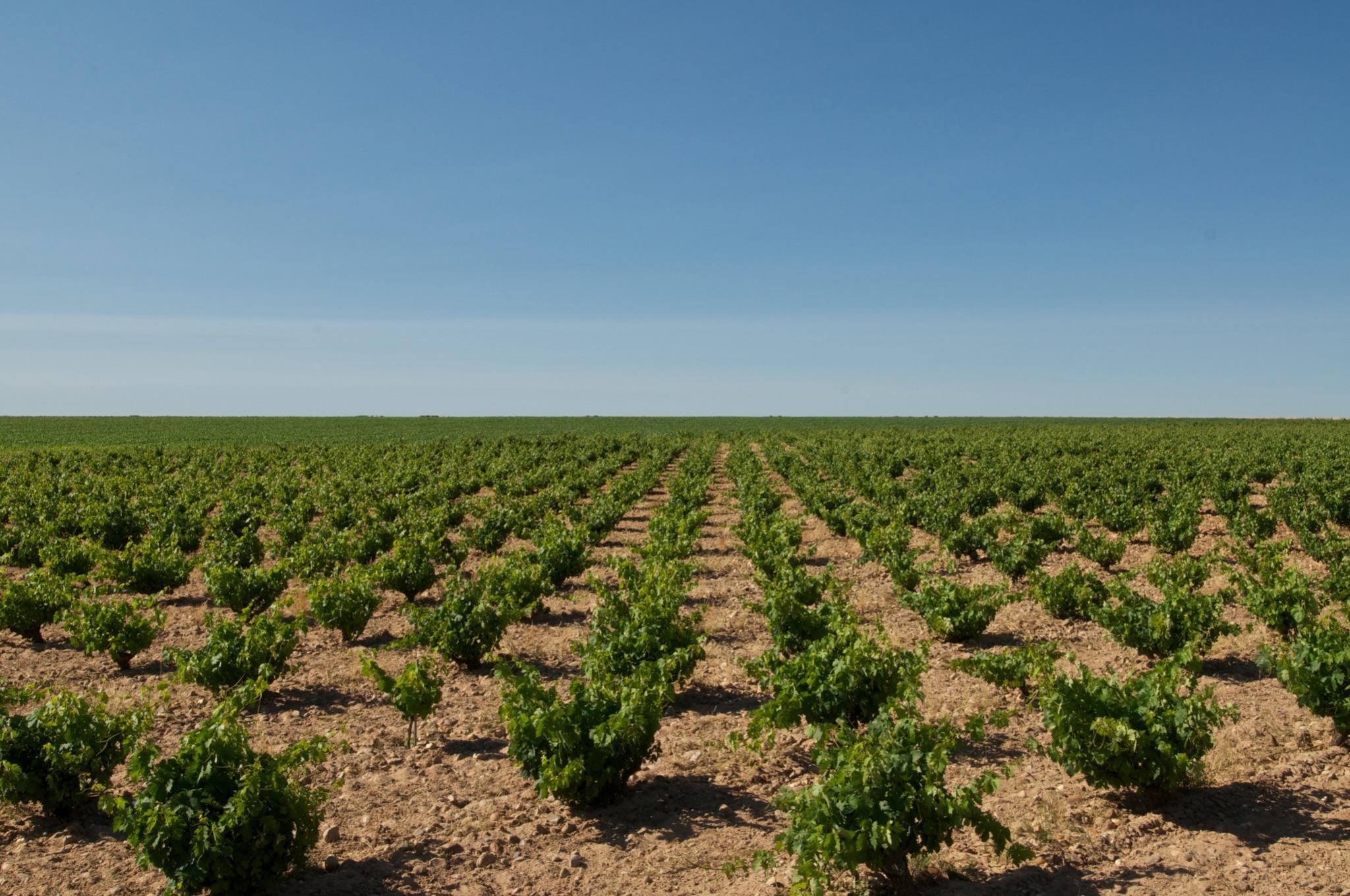
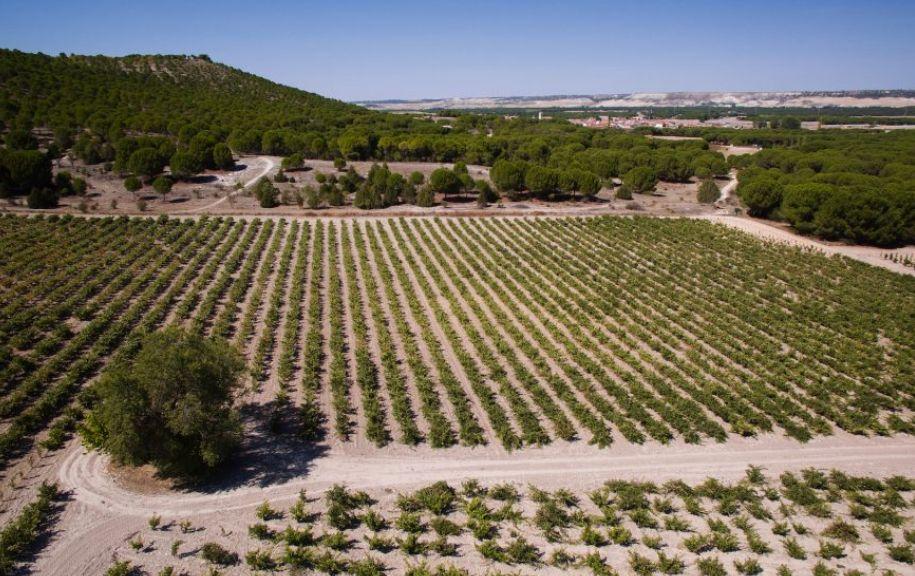
Winerysuppliesarealsoregularlyevaluatedfor their level of sustainability. When possible, Mauro purchases products that can be recycled, and if not, reduces their use where possible.
THE�FAMILY
Mariano García has worked alongside sons Eduardo and Alberto since 2001 in all three of their winery projects. There has been no generational change in management; Mariano says that he has left his sons freedom and confidence, even to make mistakes. The brothers respond good-humoredly that the sameholdstruefortheirfather.
 Eduardo, Mariano and Alberto García
Eduardo, Mariano and Alberto García
TERROIR
The topography of Mauro’s vineyards is influenced by the Duero River. In fact, the town of Tudela de Duero is known as la lágrima del Duero (tear of the Duero) due to its location in a pronounced bend of the river. The area’s flat terrain is broken up by paramos up to 2,780 feet (850 m) high. The majority of Mauro’s vineyards are on the sides of the Páramo de La Buena Rubia, someofwhichhavea15%grade.



The dominant soil of the vineyards is loose, light and deep with a sandy-clay and sandy-calcareous composition. It has a balanced texture and high pH with low rainfall. This causes water stress, mitigated by the well-developed root structure. On the páramo and its slopes, the brown soil is covered in stones, while the valleyshavegrayclaymarlandsandyclaywithgravel.


VITICULTURE�&�WINEMAKING

SIX DISTINCT VARIETIES: There are six different varieties planted in Mauro’s vineyards, although more than half the vines areTempranillo.Theaveragevineageis35yearswithyieldsbetween1.21to2.2tonsperacre(3,000and5,000kg/ha).In 2017,CabernetSauvignonwasplantedatmorethan2,640feet(800m)tohelpmaintainfreshnessinthegrapes.
ORGANIC VITICULTURE: Inadditiontoorganicpractices,someparcelsarefarmedbiodynamicallywithnaturaltreatments suchashorsetail,valerianrootandnettles.Amongthegoalsaretopromotehealthysoilbalance,minimizeerosionandhelp stimulatetheplant’snaturalimmunity.
WINEMAKING & AGING: After a staggered harvest, the cooled, selected grapes are destemmed and moved to fermentationvats.Nativeyeastsareusedinfermentation.Malolacticfermentationtakesplaceinacombinationofstainless steeltanks,oakbarrelsandvats.
Knownfortheirexpertiseinbarrelaging,Mauropracticesmicro-vinificationbyseparatingthegrapesbyplotsandvarieties from harvest until the end of aging in oak in order to respect the diversity and personality of each parcel. The French oak barrelsareallfine-grained,subjecttotwoandthree-yeardryingprocedures,andarereplacedatarateof30%eachyear.
75% of all vines are goblet-trained,though all the Godello and CabernetSauvignonis trellised. The plant densityisaround6,175 vines per acre (2,500 vinesperhectare).


How�is�the�terroir�reflected�in�the� wines�of�Mauro?
The terroir in Tudela is expressed in a precise and clearfruit,andaripeandsofttannin.


Singularities�of�the�winery
BODEGhttps://www.bode gasmauro.com/en/wines/ AS�MAURO�PORTFOLIO: Mauro, Mauro VS, Terreus, Mauro Godello
Vino de la Tierra Castilla y León
85% Tempranillo, 15% Syrah and Cabernet Sauvignon
Fermentation with native yeasts, then about 15 months in French oak foudres and barrels
Good�to�Know
Grapes from the Tudela de
MAURO�VS
Vino de la Tierra Castilla y León
100% Tempranillo
Vinification�



Fermentation with native yeasts, then about 25 months in French
Good�to�Know
Grapes from the Tudela de Duero and Transpinedo
BODEGAS�MAURO



Ctra de Villaibañez, Km 1
47320 Tudela de Duero
Valladolid
On the slopes of Priorat, Mas Doix cultivates 42 acres (17 ha) of vines in iconic Licorella soil with a timeless bedrock of slate. The estate focuses on producing classic expressions with fruit from centennial plantings of Cariñena and Garnacha. With a recently built winery designed with sustainability and energy efficiency in mind, Mas Doix now stands poised to continue its long legacy of making unexpectedly elegant, fresh wines with the classic character of Priorat.



SINCE�2004
KEY�FACTS
CLIMATE:�Mediterranean:cold,drywinters andrainysprings;dry,warmsummers,with greatthermalcontrastbetweendayandnight
ELEVATION: 820-2,132feet (250-650m)
SOILS: Predominantlydecomposedslateand shale,locallyknownas licorella
CLASS: DOQPriorat



HISTORY
Valentí and Ramon Llagostera arrived in Poboleda because of family ties with the Doix family. While harvesting the 110-year-old Garnacha and Cariñena vines in October 1998, the Llagosteras approached the Doix family about making wine with the grapes that were taken to the Poboleda Cooperative. Winemaking started in a small winery in 1999, Mas Doix’s first vintage. The Llagosteras acquired the Doix share of the project in 2015, and in 2019 went into partnership with the Cliff Lede family, owners of the eponymous winery in Stag’s Leap, Napa Valley. A new winery outside the village of Poboleda was inaugurated a year later.
VINE: 59acres(24ha),with30acres (13ha)GPEapproved;soxprincipalsites
KEY�VARIETALS:�Cariñena, Garnacha,GarnachaBlanca,Macabeo





ECO: Certifiedorganicandbiodynamic practices

INNOVATE: Experimentalirrigation system

powered by an autonomous power generating system and rainwater collection facilities. They also installed a wastewater treatment plant. All vineyards are organic and guided by biodynamic practice, such as following the lunar phases. Biodiversity efforts include planting of olive, hazelnut and native fruit trees. The entire river area is protected to allow birds, fish, amphibians andsmallmammalsintheareatoflourish.
THE�TEAM
Co-founders Ramon and Valentí Llagostera serve as head winemakers, assisted by Jordi Jutglar, director of viticulture; Sergei Batet, oenologist; and a talented viticulture team who help in harvesting, pruning and caringforthevinesonextremeslopes.


Winemakers: RamonandValentíLlagostera
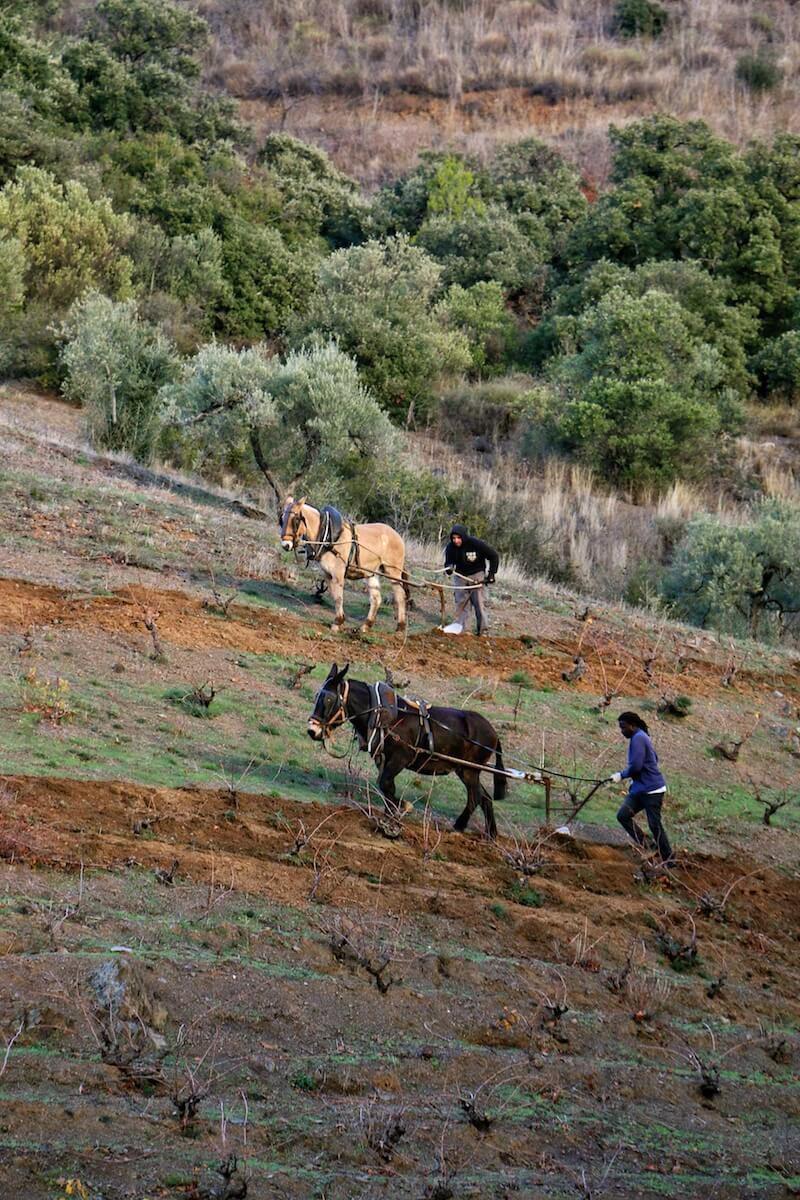
TERROIR

Located in the northeastern part of Priorat, Poboleda has lower average temperatures and a higher average rainfall than the rest of the municipalities. Of note are the sharp diurnal temperature shifts. During the summer months, temperatures can drop to 54º F (12ºC), while theycanalsoclimbtohighsof104ºF(40ºF).


There are few vineyards planted on soils as ancient as those of the Priorat. Two different types dominate: licorella on the steep slopes formedbythedisintegrationofslate,andalluvial deposits in flatter areas. The decomposed slate strata have siliceous materials and limestone cements, not calcareous. The soils are slightly acid,withaneutralpH.


 Mas Doix has six vineyards throughout Poboleda. Each has different exposures and soil composition, depending on its proximitytotheSiuranariver.At1,125feet(340m)abovesealevel,itisoneofthecoldestmicroclimatesinPriorat.
Mas Doix has six vineyards throughout Poboleda. Each has different exposures and soil composition, depending on its proximitytotheSiuranariver.At1,125feet(340m)abovesealevel,itisoneofthecoldestmicroclimatesinPriorat.
FACT: After the arrival of phylloxera in the 19th century, entire vineyards had to be replanted. Mas Doix’s “1902” bottling is sourced from 115-year-old vines from that early 20th century recovery effort.
VITICULTURE�&�WINEMAKING
VINEYARD EXPRESSION
Due to the great variability of growing sites, there is strong vineyard identity in the wines of Mas Doix. From old-vine Garnacha growing on hillsides to high exposure terraces of Cariñena, each plot shows remarkable specificity matched to the most appropriate varietal. For example, the Tossal d’en Bou vineyard has been declared a Gran Vinya Classificada (GrandCru)withthenewvineyard’sclassificationinDOQPriorat.Locatedbetween1,476and1,640feet(450and500m) ofaltitudewithsouthernorientation,itprovides extendedripeningtimeforCariñena.Theresultsareanexcellentbalance betweenacidityandphenolicripening. Otherwise,thebestPrioratvineyardsfacenorthsothattheyarenotroastedbythe late-afternoon sun. With almost no summer rainfall and zero irrigation, yields are incredibly low—as little as four or five fist-sizedbunchespervine.

MINIMAL INTERVENTION VINIFICATION
All fruit is harvested by hand with minimal manipulation in the cellar. Selection happens three times: first in the field, then as the fruit arrives at the winery, and finally after destemming. These methods allow Mas Doix to preserve the essence of thegrapeandgrowingsite.Limitedyieldsresultinfreshandelegantwineswithasubtleminerality.

Mas Doix farms 100-year-old Garnacha and Cariñena vines. Old vine fruit is prized for healthy root structure and spectacular concentration.

The soil is mostly decomposed slate and shale, with very little organic material. This composition facilitates drainage and is porous enough to allow vine roots to reach deeper than anywhere else on earth. This slate soil shows in the wine as a pronounced minerality typical of many wines of the Priorat. Since the soils are slightly acidic, there is tension and verticality to the wines. Stress due to the lack of organic matter produces concentrated grapes with extremelyhighphenolicmaturity.
The winds also play a factor in the vineyards. Usually, the main winds blow from the northwest. This dry wind is known as El Sereno and originates from the interior of Spain.


considerably lessens the effects of the hottest summer days, maintaining freshness in the wines and theexpressionofterroir.
Singularities�of�the�Winery



The vineyards are located in the coolest part of the Priorat. Mas Doix’s new winery permits them to be self-sufficient, without the need for external energy andwatersupplies.





Why�is�Mas�Doix�a�Grandes�Pagos�de� España�winery?
MAS�DOIX�PORTFOLIO:

Good�to�Know
Contact:�Valentí�Llagostera valenti@masdoix.com
Masdoix.com @masdoixwinery
1902, 1903, Murmuri, Salix, Les Crestes
55% Carignan and 45% Garnacha
Fermentation in stainless steel; 3 weeks of maceration before grapes are pressed and barrel
Fruit from 110-year-old Carignan vines and 80-year-old Garnacha
Grapes grown exclusively on steep with very low yields of 10.5 ounces of grapes per vine
Founded in 1729 by Diego de Alvear y Escalera, Alvear is the oldest family winery in Andalusia and the second-oldest in Spain. The estate has passed ownership from parent to child for eight generations, maintaining a consistent lineage across time. Farming the famed Montilla vineyard, Alvear is known for its mastery of the Pedro Ximénez grape, with some barrels on site aging over 200 years. With this legacy supporting it, Alvear’s ongoing ambition is to preserve this rich tradition while innovating for the years to come.



SINCE�2018
KEY�FACTS





CLIMATE: Semi-continental Mediterranean, with warm, long, dry summers and mild winters; average growing season temperature 70°F (21°C)
ELEVATION:�820 - 1,476 feet (up to 650 m)
SOILS: Albariza: chalky soil with high limestone content, mixed with sand and clay

CLASS: DO Montilla-Moriles

HISTORY
Alvear was founded by Diego de Alvear y Escalera in 1729, and is the second-oldest Spanish winery still in operation. In the 19th century, Sabina Alvear Ward discovered the potential of the Pedro Ximénez grape, Alvear’s calling card to this day. Also early in 19th century, cellar master Carlos Billanueva began marking the best casks with his initials “C.B.”, which gave rise to the house style. The Fino C.B. label is the fifth-oldest in Spain still in use and is made from the best P.X. musts. Now in its eighth generation, Alvear continues to produce wines reflective of this long history.

VINE: 427 acres (173 ha) across 21 plots are GPE-approved

KEY�VARIETALS:�Pedro Ximénez

ECO: Integrated viticulture
INNOVATE: Searching for new expressions of the Pedro Ximénez grape, while exploring the roots and particularities of Montilla vineyards
waste in the vineyard and cellar. They have a recycling program on site, and, rather than letting byproducts of vinification go to waste, they sell off lees and skins. Alvear is also in the process of obtaining the “Wineries for Climate Protection” certificate, which is granted by a collaborative group of wineries committed to reducing carbon emissions across the wine industry. Alvear exclusively practices integrated viticulture, and commits to a minimum use of herbicides and pesticides, givingprioritytoonlythemostsustainableand ecologicalpractices.


THE�FAMILY�&�TEAM
Fernando and Luis Giménez Alvear are the eighth generation of the family, now leading the winery. They are backed by Bernardo Lucena, who has been the mainwinemakerforlast30yearsandwhoisoneofthe foremost experts in biological aging in the region. Together they developed legendary wines like Palo Cortado Abuelo Diego, Amontillado Solera Fundación and PX Solera 1830. Since 2019, Alvear winery counts onarefreshingcollaborationwithSanlucanWinemaker RamiroIbáñez.HeisanexpertintheterrainofSierrade Montilla, and participates in the creation of 3 Miradas rangeofwines.

TERROIR

The core of Alvear’s terroir is the Montilla vineyard. Montilla features albariza soil, which is mainly chalky, high in limestone, porous and poor in organic material. Whiletypicallylowerinyield,thegrapesaresubjecttoa longer and more balanced ripening process. Ruedos are patches of red earth with iron salts, where the grapesmatureearlier.
From the viticultural point of view, Montilla is classified among the warmest in the world during the vegetative cycle. There is little rainfall and high insolation, which affects the development of the vine and its phenological cycle. The Albariza soil’s capacity to retain moisture helps mitigate the lack of precipitation, giving thewinesarefreshingmineral-salinecharacter.
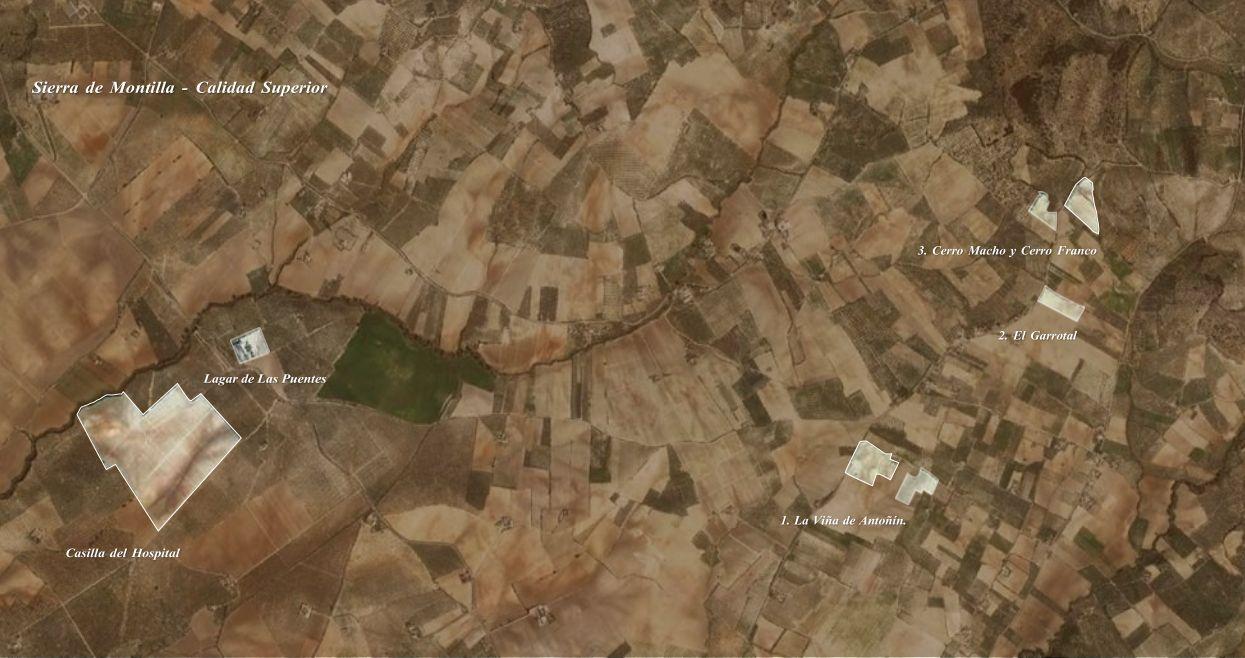





VITICULTURE�&�WINEMAKING

MONTILLA VINEYARD The Montilla Vineyard is one of the factors that makes Alvear singular. The Pago de Benavente and Pago de Riofrío are at the highest elevations in the area (2,000 ft.; 610 m) and their parcels have many different orientations. They are planted with head-trained old-vine Pedro Ximénez and short-pruned with a traditional technique called alaciega.Thisencourageslowcanopygrowthtoshadethegroundaroundthevine.
PEDRO XIMÉNEZ The calling-card of the estate, the Pedro Ximénez grape is used to produce Alvear’s wine. Styles range from dry still wines, finos, amontillados, olorosos and sweet wines. The grape has thin skins and high sugar content, permittingthevinificationofrichsweetwines,andfinosandamontilladoswithoutfortification.
AGING UNDER A VELO DE FLOR For their fino and amontillado wines, Alvear ages the wine under velo de flor, literally “veil of yeast.” This is a natural biological process whereby a cream-colored cap of yeast indigenous to the region develops onthetopofthewine.Alvear’s velo ismadeofnativeyeasts,S.Montuliensisandothers,alsoconsideredanintegralpartof theterroiroftheirwines.The velo isevenusedintheirdrywhitewinerange,3Miradas,toimpartlight,yeastyaromas.
To make sweet P.X. wines, the fruit is exposed to the sun after harvest. Grape clusters are spread over plaited grass mats and slowly sun-dried until they become raisins. A dense must is then taken from the crushed raisins, and the subsequent winemaking and aging processes give rise to the region’s much-loved sweet wines.


How�is�the�terroir�reflected�in�the� wines�of�Alvear?
ThewinesthatleaveAlvearalwaysevoketheidentity ofMontillathrough:
Pedro Ximénez:aromasofpear,apple,fennel,anise
Expression of albariza soil:salinity/savorinessand "mineral"freshness,andfiner,verticalwines
Expression of the velo de flor (yeast veil): strainsof nativeyeasts,S.Montuliensisandothers,whichare partoftheterroirandprovideverytypicalaromas, helpingtocreatethewinerystyle–elegantwines, withoutstrong,pungentaromas,alwaysstrivingfor freshness,moreaniseandcitrusaromasofthePX, andtypicalaromasoftheyeastveil.


ALVEAR�PORTFOLIO:

3 Miradas Range (Vino de Pueblo, Cerro Franco, Cerro Macho) P.X. de añada, Fino Capataz, Fino en Rama Carlos VII, Oloroso Asunción, Oloroso Catón, Palo Cortado Nº7, P.X. Solera 1927
3�Miradas�Vino�de�Pueblo
DO Montilla - Moriles
Varieties
100% Pedro Ximénez
Vinification
Fermented in concrete jars and rested up to 8 months with yeast veil
Good�to�Know
Old-vine fruit from pagos Río Frío Alto and Benavente
Singularities�of�the�Winery
Alvear is the oldest winery in Andalusia, and the second-oldest still in operation in Spain. With almost 300 years of history, the winery has treasures such as a solera with an average age of 100 years. They were also the first to champion the versatility of the Pedro Ximénezgrape,stillahallmarkofthehouse.
Why�is�Alvear�a�Grandes�Pagos�de� España�winery?
As pioneers of both the Montilla region and the Pedro Ximénez grape, Alvear aims for all of their wines to carry the imprint of their terroir. This and their passion for innovation led them to join other wineries in the pursuit of single-estate quality in GPE.



P.X.�de�Añada
DO Montilla - Moriles
Varieties
100% Pedro Ximénez
Vinification�


Sun-dried grapes pressed in traditional vertical press, fortified rested in concrete cones for at least a year
Good�to�Know
Made with grapes from a single vintage
ALVEAR
Av. de María Auxiliadora, 1 14550 Montilla
Córdoba
ALVEAR.ES �����@BODEGAS_ALVEAR Contact:�Alvaro�Ruiz export@alvear.es LEARN�MORE
For more information about The Terroir Workshop, including updates on upcoming class schedules, please register here

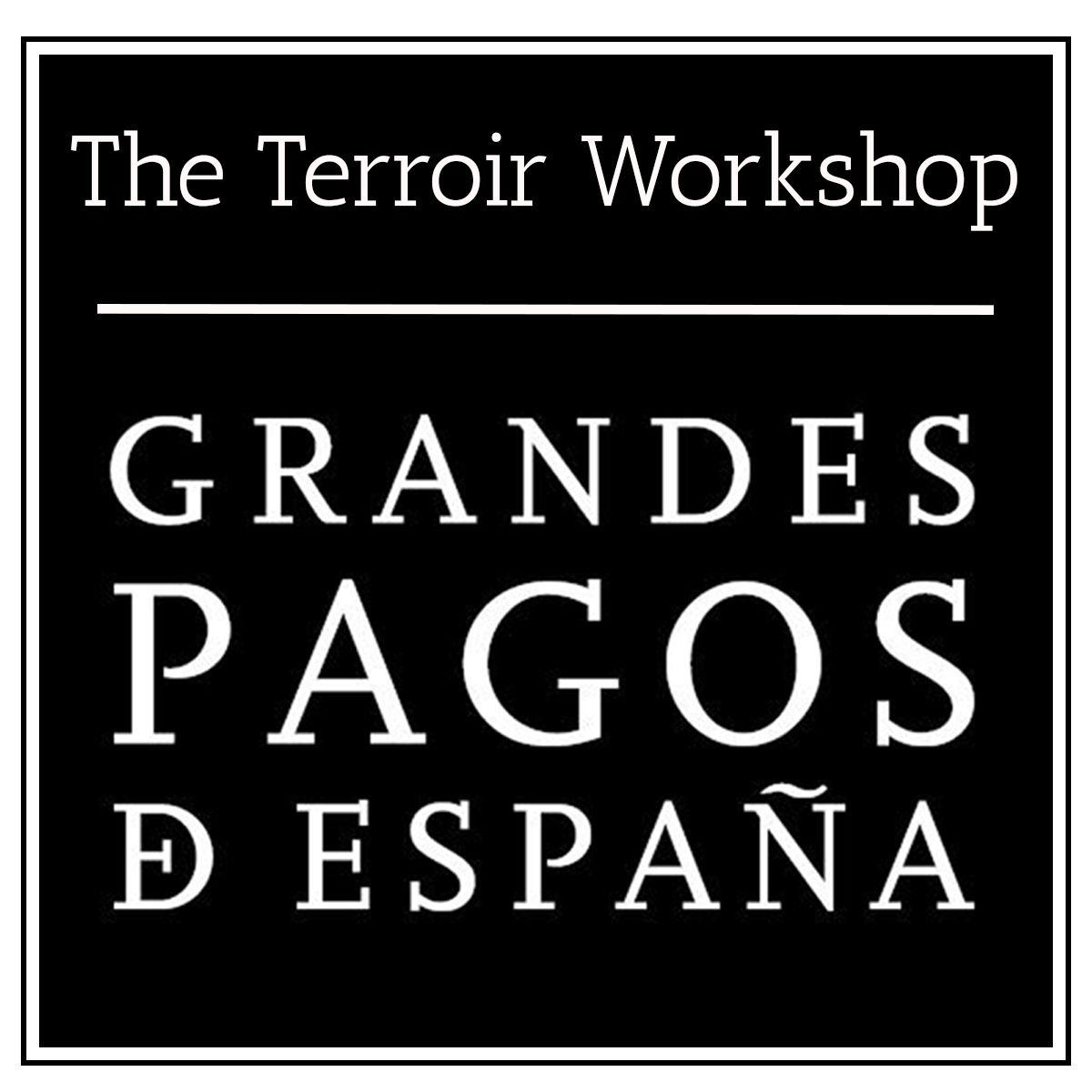
































































 La�Seca
La�Seca














 Winemaker: Javier Revert and Winery Partner Germán GarcíaCordero
Winemaker: Javier Revert and Winery Partner Germán GarcíaCordero





















































 Eduardo, Mariano and Alberto García
Eduardo, Mariano and Alberto García





















 Mas Doix has six vineyards throughout Poboleda. Each has different exposures and soil composition, depending on its proximitytotheSiuranariver.At1,125feet(340m)abovesealevel,itisoneofthecoldestmicroclimatesinPriorat.
Mas Doix has six vineyards throughout Poboleda. Each has different exposures and soil composition, depending on its proximitytotheSiuranariver.At1,125feet(340m)abovesealevel,itisoneofthecoldestmicroclimatesinPriorat.



























